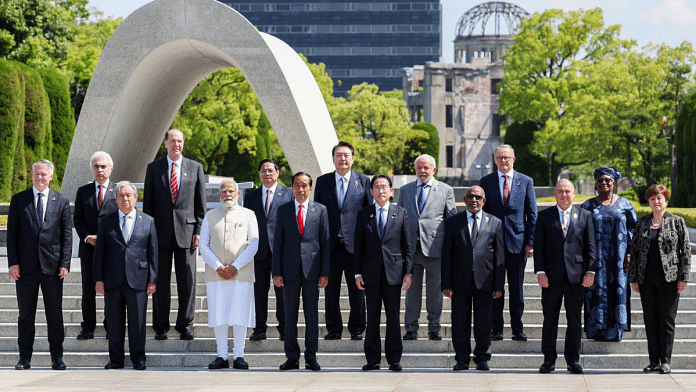India was invited as a guest country to the G7 summit held in Hiroshima, Japan in May. This was not the first time. France too had invited India for the G7 in 2019 followed by the US in 2020 (which though was not held due to the pandemic), Britton in 2021 and Germany in 2022. It appears that India is only a few steps away from becoming a full member of the G7 in near future.
In May this year, President Volodymyr Zelensky of Ukraine strayed out of his bunker somewhere in Kiev and went globetrotting to Jeddah, Saudi Arabia, and Hiroshima, Japan where the G7 meeting was in progress and where he met the Indian Prime Minister. None of the country heads Zelensky met during his outing are competing with either the US or China in the global power struggle. The Ukrainian President though was aware of the cumulative strength of these countries, which included India, Brazil, Saudi Arabia and Indonesia.
In a move that took many political and economy watchers by surprise, China brokered a peace deal between Saudi Arabia and Iran, two countries on the opposite spectrum of religion and civilisational past. Why Beijing brokered a deal between two middle powers is no secret; it’s upping the ante in the global power struggle.
Before the 2019 G7 summit, Prime Minister Narendra Modi, Russian President Vladimir Putin, and the Turkish President Recep Tayyip Erdogan greeted each other at the BRICS summit in Johannesburg, South Africa, in July 2018. Erdogan has been re-elected since then, Putin is undaunted by the western sanctions and Narendra Modi is all set for his third term as prime minister. Besides the rare photo opportunity, the handshake signalled a new realignment of regional forces. Not that these three countries have a common forum or are inseparable friends with no contentious issues. They have their list of bilateral and trilateral differences, if not major irritants, to step on one another’s’ toes. But their joining hands speaks more for the prospects of the re-alignment of middle powers.
Also read: India-US ties reaching a turning point. But General Electric won’t ever get us complete tech
What are middle powers
Theoretically speaking, middle powers are countries which are not as strong as a superpower but are strong enough to wield significant influence in international affairs. In reality, countries like India have emerged as strong middle powers as they prefer multilateral solutions for global problems and have negotiated settlements for bilateral conflicts. Even by traditional parameters like higher GDP ratio, trade volume, sufficient foreign exchange reserves, stabilised economy and a good defense mechanism. Importantly, in the present global context, ability to determine the position of the existing and contesting superpowers in the global arena appears to be an important attribute of a middle power.
Middle powers are slowly but surely emerging in the geopolitical and geo-economic horizon, indicating the beginning of a new chapter in global power positioning. Call them mere emerging economies or more uncharitably, fence sitters in the ongoing Russia-Ukraine conflict, the middle powers are guided by their respective national interests and compulsions of regional complexities and considerations.
While America has no ‘region’ of its own, expansionist China in its hegemonic urge has aggrandised its ‘regions’ into its geography. Not having to deal with the immediate neighbourhood gives the US and China certain distinct advantages but the two contesting powers are also having to look for allies, supporters, and strategic partners from among middle powers. It is this unique “non-aligned” positioning that gives the middle powers strength in determining their stand on global issues and negotiate their way into the high table of global institutions, mainly dominated by the West or the Global North.
Unlike the sharply divided North-South, the middle powers are largely distributed in both halves, thus bridging the schism between the developed North and the developing South. The middle powers are growth engines through their huge natural resource banks, vast manufacturing capabilities and huge consumer strength, more prominently in the global South. These strengths have compelled the middle powers to create and run regional economic and trade facilitation institutions, which are now drawing the attention of global hegemons.
Also read: Delhi’s nuclear trade with US still hasn’t taken off. Expanding it can help Make in India
Shifting power balance
The global hegemons, present and the wannabe ones, will have to learn to respect and woo the middle powers and piggyback their economy rather than expect them to fall in line before their economic and military strength. It was military might in the seventies and eighties that gave a decisive victory to the US in the Cold War, rendering the world unipolar. But within a couple of years of the disintegration of the Soviet Union, the defense potential of military institutions diminished (yes, NATO has lost its sheen) chaperoning the world towards multilateralism. Now, in a multipolar world, the non-aligned middle powers have greater stakes and say in framing rules and being able to dictate terms.
Nothing has demonstrated this strength more than the G20, which under Indian presidency, has assumed much greater importance and significance. India’s suggestion of adopting life style changes to mitigate climate change disasters and emphasis on development partnerships instead of aid-driven developmental assistance for economic wellbeing are being identified as potential templates for a new economic world order.
The shifting balance of power from hegemons and bipolarity to the multipolarity of middle powers will probably determine the contours of the new economic world order, guarantee a free, open, secure and inclusive Indo-Pacific. But we need to upgrade our capabilities lest we miss the bus this time too.
Seshadri Chari is the former editor of ‘Organiser’. He tweets @seshadrichari. Views are personal.
(Edited by Anurag Chaubey)



